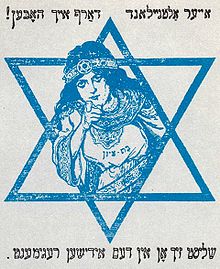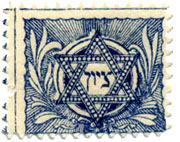Ted Pearce Zealous Over Zion
Ted Pearce Zealous Over Zion
Ted Pearce Zealous Over Zion
Etymology
The etymology of the word Zion (ṣiyôn) is uncertain.[2][3][5] Mentioned in the Bible in the Book of Samuel (2 Samuel 5:7) as the name of the Jebusite fortress conquered by King David, its origin likely predates the Israelites.[2][3] If Semitic, it may be derived from the Hebrew root ṣiyyôn ("castle") or the Hebrew ṣiyya ("dry land," Jeremiah 51:43). A non-Semitic relationship to the Hurrian word šeya ("river" or "brook") has also been suggested.[5]Orthography
The form Tzion (Hebrew: ציון; Tiberian vocalization: Ṣiyyôn) appears 108 times in the Tanakh (Hebrew Bible), and once as HaTzion.[6] It is spelled with a Tzadi and not Zayin.[7] The commonly used form is based on German orthography,[8] where z is always pronounced [t͡s] (e.g. "zog" [t͡soːk]), hence "Zion" in German literature. A tz would only be used if the preceding vowel is short, and hence use of Zion in 19th-century German Biblical criticism. This orthography was adopted because in German the correct transliteration can only be rendered from the one instance of HaTzion in Kings II 23:17, where the a vowel is followed by a double consonant tz.In the Hebrew Bible
Some examples from the book of Psalms, which have been frequently recited and memorized by Jews for centuries, state:- "By the rivers of Babylon, there we sat down, yea, we wept, when we remembered Tzion." (Psalms 137:1)
- "For there they that carried us away captive required of us a song; and they that wasted us required of us mirth, saying, Sing us one of the songs of Tzion. How shall we sing the Lord's song in a strange land? If I forget thee, O Jerusalem, let my right hand forget her cunning. If I do not remember thee, let my tongue cleave to the roof of my mouth; if I prefer not Jerusalem above my chief joy. Remember, O Lord, the children of Edom in the day of Jerusalem; who said, Raze it, raze it, even to the foundation thereof; O daughter of Babylon, that art to be destroyed; happy shall he be, that repayeth thee as thou hast served us." (Psalms 137:3-8, italics for words not in the original Hebrew)
- "The Lord doth build up Jerusalem: he gathereth together the outcast of Israel. Praise the Lord, O Jerusalem; praise thy God, O Tzion." (Psalms 147:2,12)
The Daughter of Tzion
Mentioned 26 times in the Tanakh, the Biblical phrase "Daughter of Tzion" (Hebrew "bat Tzion") is a reference to Mount Moriah (the Temple Mount) in Jerusalem. A cryptic verse in the book of Zechariah, Zechariah 4:7, seems to refer to Mount Moriah, but may be ambiguous, depending on the punctuation. In Hebrew it reads "Mi attah Har-haGadol lifnei Zerubbabel l'mishor..."; the plain text has no punctuation, but the Masoretic Text puts a pause following Har-haGadol, to mean "Who are you, great mountain? Before Zerubbabel, [you will become just] a plain..." However, if the pause is placed following Zerubbabel, it would mean instead "What are you, "great mountain" before Zerubbabel? [You are just] a plain..." Since this hill is where Zerubbabel built the Second Temple, it appears to be a reference to the "Daughter of Zion" (the hill), as distinct from Tzion (the mountain).However, "Daughter of Zion", and a variety of other names like "Daughter of Jerusalem", might also be interpreted as referring to Jerusalem, the Holy Temple, and the Jewish people personified, instead of a Mount Moriah specifically.[9]
Judaism
Zion is the Hebrew name for the Temple Mount in Jerusalem and was the seat of the first and second Holy Temple. It is the most holy place in the world for Jews, seen as the connection between God and humanity. Observant Jews recite the Amidah three times a day facing Zion in Jerusalem, praying for the rebuilding of the Holy Temple, the restoration of the Temple service, the redemption of the world, and for the coming of the Messiah.Arab and Islamic tradition
Sahyun (Arabic: صهيون, Ṣahyūn or Ṣihyūn) is the word for Zion in Arabic and Syriac.[10][11] Drawing on biblical tradition, it is one of the names accorded to Jerusalem in Arabic and Islamic tradition.[11][12] A valley called Wâdi Sahyûn (wadi being the Arabic for "valley") seemingly preserves the name and is located approximately one and three-quarter miles from the Old City of Jerusalem's Jaffa Gate.[10]The Kaaba in Mecca was also called Sahyun or Zion by Muhammed, the prophet of Islam.[12] Islamic scholarship sees many passages of the Bible that refer to the desert or eschatological Zion as references to the holy site of Mecca.[13] For example, the reference to the "precious cornerstone" of the new Jerusalem in the Book of Isaiah 28:16 is identified in Islamic scholarship as the cornerstone of the Kaaba.[13] This interpretation is said by Ibn Qayyim al-Jawziyah (1292–1350) to have come from the People of the Book, though earlier Christian scholarship identifies the cornerstone with Jesus.[13]
Christianity
In the New Testament the Daughter of Zion is the bride of Christ, also known as the Church, according to the writer of the book of Hebrews (see Heb 12:22). In this sense the lower hill with the temple mount is of course the Daughter of Zion as a geographical or 'earthly' manifestation of spiritual reality, as well as the lively and alive place of the human congregation.Naming the holy city "daughter Zion" was a common practice in the Hebrew language. Not only Jerusalem was called this way, but also Babylon, Tyre and Tarshish were referred to as "daughter".[14]
Latter Day Saint movement
Main article: City of Zion (Mormonism)
A similar metaphoric transformation of the term "Zion" occurs in the modern Latter Day Saint movement,
originating in the United States in the 1830s. In this interpretation,
Zion refers to a specific location to which members of the millennial
church are to be gathered together to live. During that time the ancient
city of Enoch, also named Zion, that was taken to Heaven will return to
the Earth. A Temple is to be built unto the Lord for a sacred work to
be performed and for the Lord Jesus Christ to reign when he returns
at the Second Coming. Until the gathering of Israel (Gentile and Jew
who have accepted Jesus as their savior), when the second coming of
Jesus Christ.[clarification needed]Latter Day Saints also believe their location congregations to be the stakes of Zion, where they gather weekly to renew vows and covenants made to God the Father and to the Son of God.
Zionism

A World War I recruitment poster. The Daughter of Zion (representing the Hebrew people): "Your Old New Land must have you! Join the Jewish regiment".
While Zionism is based in part upon Torah mitzvot linking the Jewish people to the Biblical land of Israel, the modern movement is largely secular.[citation needed].
The last line of the Israeli national anthem ("Hatikvah"...Hope) is ...."Eretz, Zion, Yerushalayim", which means literally Land, Zion, Jerusalem. Yerushalayim is a plural, because there are 2 "Jerusalems" in Judaism, there is the physical land and the spiritual spot where God's presence on Earth (Shechinah) is centered.
In 2005, Ralph Uwazuruike from Nigeria pushed for the creation of the already disputed state of Biafra for the Igbo people. He approached the Israeli government to support this movement on the basis that Israel is the long lost home of the Igbos.
Anti-slavery symbolism
The Jewish longing for Zion, starting with the deportation and enslavement of Jews during the Babylonian captivity, was adopted as a metaphor by Christian Black slaves in the United States, and after the Civil War by blacks who were still oppressed. Thus, Zion symbolizes a longing by wandering peoples for a safe homeland. This could be an actual place such as Ethiopia for Rastafari or Israel for some of the Igbos in Nigeria for example. For others, it has taken on a more spiritual meaning—a safe spiritual homeland, like in heaven, or a kind of peace of mind in one's present life.Rastafari movement
In the Rastafari movement, "Zion" stands for a utopian place of unity, peace and freedom, as opposed to "Babylon", the oppressing and exploiting system of the materialistic modern world and a place of evil.[16][16]It proclaims Zion, as reference to Ethiopia, the original birthplace of humankind, and from the beginning of the movement calls to repatriation to Zion, the Promised Land and Heaven on Earth.[17] Some Rastafari believe themselves to represent the real Children of Israel in modern times, and their goal is to repatriate to Ethiopia, or to Zion.
| “ | I say fly away home to Zion, fly away home...One bright morning when my work is over, man will fly away home... | ” |
|
—Rastaman Chant , The Wailers
|
||
Mount Zion today

Dormition Church, situated on the modern Mount Zion
In popular culture
Zion is referenced in several media and entertainment groups. For example in music the band with the name Mind Zion also there are song titles such as "To Zion", a song by Lauryn Hill, "Road to Zion", by Damian Marley, "Iron Lion Zion" by Bob Marley, or the "Zion (David Bowie song)". It is referenced in the song "Pancake" by Tori Amos from her concept album "Scarlet's Walk". In film, Zion is a fictional human-controlled underground city, near the Earth's core, and is the last bastion for human civilization in The Matrix (franchise). In literature, Zion is a space station in the 1984 cyberpunk novel Neuromancer. The first two verses of Psalm 137, which mention Zion, were used for a musical setting in a round by English composer, Philip Hayes. Don McLean covered the song as 'Babylon', which was the final track on his 1971 album, American Pie. The 2011 Bright Eyes Album The People's Key referenced Zion in the song "Haile Selassie" "Hitchhiking back to Zion, Holding our tears as we flip the album" It is also referenced in the song "Ya Hey" by Vampire Weekend. The band Soulfly refers to Zion in their song "Prophecy".
Ephraim Moses Lilien, Zion, 1903.

Lilien, Stamp for the Keren Kayemet, Vienna, 1901-2. The symbolic design presents a Star of David containing the word Zion in Hebrew characters.
In Kabbalah the more esoteric reference is made to Tzion being the spiritual point from which reality emerges, located in the Holy of Holies of the First, Second and Third Temple.[4]



No comments:
Post a Comment